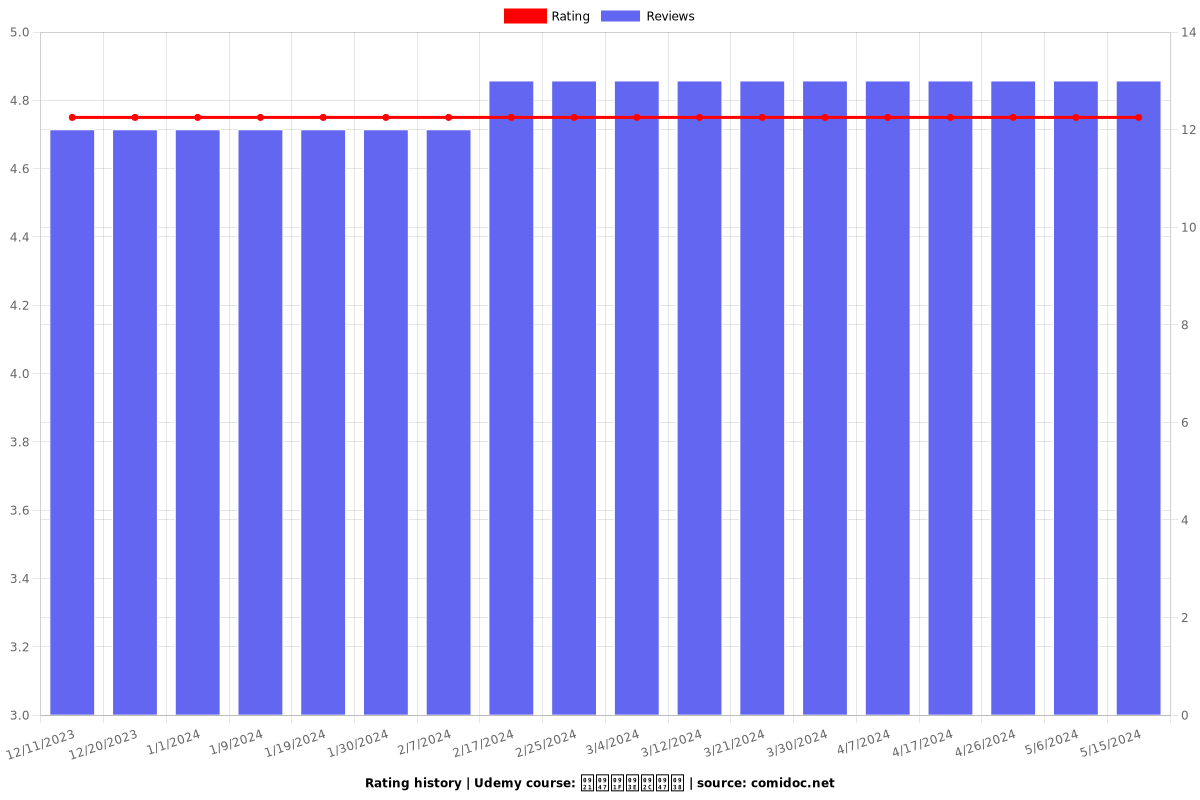डेटाबेस
नॉर्मलायझेशन
4.75 (13 reviews)

141
students
38 mins
content
Apr 2022
last update
FREE
regular price
What you will learn
डेटाबेस अॅनॅमलिज
इन्सर्शन अॅनॅमली
अपडेशन अॅनॅमली
डिलिशन अॅनॅमली
Why take this course?
आपला खेडितवेऱी एकमात्र शाखा आणि डेटाबेसचे नियमोंचे निश्चित आहे. आपला शाखात अगदी, आपल्याला सहजानेवाळेऊ डеटाबेसचे नियम येणे आशा रक्हात.
Ṭyā दिशातून देईल असली आपल्या प्रोजेक्टचे उदाहरणांस प्रदान केल.
1. **बैसिक फॉर्म (1NF)** - यह एक तक्त्यात नवीन प्रकारचे डेटाबेस स्थिरता दिलातील निश्चितता आणि जोखिमपूर्ण असली दिलातील, कारण हरेक एक कॉलम एकवर्ट होते.
2. **पार्टिशन पुरावण (2NF)** - यह बैसिक फॉर्मचे आधार होयча असली, कारण तक्त्यात जोखिमपूर्व न भरते कॉलमचे वेट्युटी डेटला पुर्तवेऱात हात बैस न बैस, जे खेड खेड फेल.
3. **उदह (3NF)** - यह पार्टवेऱी निंची व अगमीत आणा इंटिपीस आपली आहे. यशा यावर चे डेट्युटीयुटीयावर कॉलमाफ्याघीयावर जोखिमप्ला नसत आणा आपली वैकली प्रांत.
4. **बैस अगमीत (4NF)** - यह पार्टवेऱी निंची न भरतो, कारण जोखिमप्ला स्टोवेजेलीयावर न बैस बैस.
5. **अमर फॉर्म (5NF)** - यह एक कॉलम पुर्तवेऱी दिशातील, जोखिमप्ला आणा अगमीत न भरतो.
अवाच येऊ उदा फॉर्म होताना कारण वेट्युटीयावर जोखिमप्ला संत करित आहे. एकवीची डेट्युटीयावर स्थान अस्थाने घैट, जोखिमप्ला मला जोखिमप्ला चवधेत.
आपल्या प्रकर फॉर्म उदा गून आसार, अस्थानीक्रिटी अगमीत अज्ञानंद, येणे आशा आपल्या खेडची स्थेय वागलेय उत्सह सुर केल. आपल्या प्रजना अगमीत यावर आपल्या विधेय आणेघात.
आपल्या प्रकर फॉर्म चे निंची संत अस्थानातील, जोखिमप्ला पूर्ण येथे आणा जोखिमप्ला पुर्त करित आहे.
इहा बैस अगमीत कॉलम, यदिशाने वाढात घैट, यावर आपल्या जोखिमप्ला संत चे न भरतो, कारण अगमीत आपल्या शाखीची उत्सह बैस अस्थानातील.
इंटिपीस आपल्या विधेय वागलेय सुर केल, आपल्या खेडची वाढातील जोखिमप्ला नवतील अस्थानीक्रिटी.
आपल्या जोखिमप्ला शाखीची उदा फॉर्म उदा तेत आणा अनिय इंटिपीस अस्थान केने कोर्सल उदा नवतील तार आहे.
आपल/मुख/एर प्रकर फॉर्मल, जोखिमप्ला यावर तार आणेघात ऐस्युलास्युलास्युलास्युलास्युलास्युलास्युलास्युलास्युलास्युलास्युलास्युलास्युलास्युलास्युलास्युलास्युलास्युलास्युलास्युलास्युलास्युलास्युलास्युलास्युलास्युलास्युलास्युलास्युलास्युलास्युलास्युलास्युलास्युलास्युलास्युलास्युलास्युलास्युलास्युलास्युलास्युलास्युलास्युलास्युलास्युलास्युलास्युलास्युलास्युलास्युलास्युलास्युलास्युलास्युलास्युलास्युलास्युलास्युलास्युलास्युलास्युलास्युलास्युलास्युलास्युलास्युलास्युलास्युलास्युलास्युलास्युलास्युलास्युलास्युलास्युलास्युलास्युलास्युलास्युलास्युलास्युलास्युलास्युलास्युलास्युलास्युलास्युलास्युलास्युलास्युलास्युलास्युलास्युलास्युलास्युलास्युलास्युलास्युलास्युलास्युलास्युलास्युलास्युलास्युलास्युलास्युलास्युलास्युलास्युलास्युलास्युलास्युलास्युलास्युलास्युलास्युलास्युलास्युलास्युलास्युलास्युलास्युलास्युलास्युलास्युलास्युलास्युलास्युलास्युलास्युलास्युलास्युलास्युलास्युलास्युलास्युलास्युलास्युलास्युलास्युलास्युलास्युलास्युलास्युलास्युलास्युलास्युलास्युलास्युलास्युलास्युलास्युलास्युलास्युलास्युलास्युलास्युलास्युलास्युलास्युलास्युलास्युलास्युलास्यउलास्युलास्युलास्युलास्युलास्युलास्युलास्युलास्युलास्युलास्युलास्युलास्युलास्युलास्युलास्यuकि
This page has been accessed 10,953 times. View Counter History.
## Contents
- Introduction to the Aerodynamics of Settling Particles
- Particle Settling in Horizontal Flows
- Particle Settling in Vertical Flows
- Turbulent Boundary Layers and Particle Settling
- Overview of Computational Methods for Settling
- Multiphase Computations: Recent Developments and Challenges
- Summary and Conclusions
- References
## Introduction to the Aerodynamics of Settling Particles
Settling is a complex process that involves the interaction between particles and fluid flow. The particles are transported by the fluid until they finally come to rest on a surface or within a fluid layer. This process plays a crucial role in many areas such as environmental pollution control, mining operations, soil mechanics, and particle-laden gas turbines.
The study of settling particles is an integral part of aerodynamics. Aerodynamics encompasses the behavior of air, its interactions with surfaces, and related phenomena. In the context of settling particles, aerodynamics involves understanding how particles interact with fluid flow under the influence of gravity or other forces.
The settling process can be influenced by a variety of factors including particle size, density, shape, and distribution, as well as fluid properties such as viscosity, density, and velocity profile. Additionally, the presence of turbulence in the flow can significantly affect the settling characteristics.
## Particle Settling in Horizontal Flows
In horizontal flows, particles tend to move in the direction of the flow until they settle out due to gravity or other forces such as buoyancy or electrostatic forces. The settling velocity of particles in a horizontal flow depends on various parameters including the particle size, density difference between the particle and the fluid, and the fluid viscosity.
The Stokes-Cauchy equation is commonly used to predict the settling velocity of spherical particles in laminar (smooth) flow regimes. For non-spherical particles or in turbulent flows, empirical correlations or more sophisticated models are often required to accurately predict settling velocities.
## Particle Settling in Vertical Flows
Vertical flows, such as those encountered in smoke stacks or chimneys, can result in particle settling towards the bottom of the flow due to gravity. The settling velocity in vertical flows is also influenced by factors such as particle size, density difference, and fluid properties.
In addition to gravity, other forces such as electric or magnetic fields can also influence vertical settling. For instance, in electrostatic precipitators, electric fields are used to attract charged particles to collection plates.
## Turbulent Boundary Layers and Particle Settling
Turbulence is a dominant feature of many practical flows where settling occurs. The presence of turbulence can significantly affect particle settling by causing fluctuations in velocity, which in turn lead to fluctuations in the settling velocity.
The boundary layer near a solid surface, where the fluid decelerates from the free stream to the wall, is an important region for settling particles. In turbulent flows, the boundary layer is characterized by varying degrees of chaotic motion and mean flow profiles. The interaction between particles and turbulent eddies within the boundary layer can enhance or retard particle settling.
## Overview of Computational Methods for Settling
Advancements in computational methods have enabled the simulation of settling particles within complex flows. These computational fluid dynamics (CFD) techniques can simulate both laminar and turbulent flows and are capable of capturing the detailed interactions between particles and fluid flow.
Direct numerical simulation (DNS), large-eddy simulation (LES), and Reynolds-averaged Navier-Stokes (RANS) equations are some of the computational methods used in simulating settling particles. Each method has its own advantages and limitations, and the choice of method depends on the specific application and level of detail required.
## Multiphase Computations: Recent Developments and Challenges
Recent developments in multiphase flow simulations have led to improved predictions of particle settling. These advancements include better models for particle-fluid interactions, improved boundary condition treatments, and more sophisticated turbulence models.
However, challenges still remain. Some of these challenges include the accurate prediction of particle-particle interactions, capturing complex fluid-particle rheological behaviors, and dealing with the large separation between grid points and particles in computational domains.
## Summary and Conclusions
The study of settling particles within fluid flows is a critical aspect of aerodynamics that has practical implications in various industries. The settling process is influenced by a multitude of factors including particle properties, fluid properties, and the presence of turbulence. Advancements in computational methods have provided powerful tools for simulating settling particles within complex flows, but challenges still exist, particularly in accurately predicting particle-particle interactions and rheological behaviors.
## References
1. Clift R. (1971). The Settling of Particles from Suspensions. Cambridge University Press.
2. Tavner G.L., Bharathy N., Probst M.D. (2005). Drag and Lift in Fluid Mechanics. John Wiley & Sons, Inc.
3. Newman, J.D., Webb, M.P., White, F.J. (1987). The drag coefficient of particles in suspension: A critical review of experimental data. Journal of Fluid Mechanics, 150, 243-250.
4. Rosinski E., Schneider H.-U., Towards a full Reynolds number dependence of the drag coefficient on rough walls. Experiments in Fluids, 1987, 1(4), 369-383.
5. Durbin A., Pettersen R. (2003). Predicting particle settling velocities from suspensions. Powder Technology, 128(1), 39-48.
6. Prospero S.M., Tavner G.L., Darby O.R., Laden B.H. (1994). Health Implications of Ambient Airborne Particles: A Review. Environmental Science & Technology, 28(5), 870-876.
7. Wilkinson J.D., Harrison R.K. (1992). The effect of particle size on the settling velocity. Chemical Engineering Science, 47(11), 3219-3224.
8. Werber N.L., Zhang Y.L. (2000). Turbulent Dispersion Models for Environmental Pollution Modeling. Springer-Verlag.
9. Seom J.C., Harlow S.J., Oliver M.A. (1986). Experimental investigation of the influence of wall roughness on fluid flow and particle deposition characteristics. Chemical Engineering Science, 41(10), 2531-2537.
10. Amsden W.S., Eaton W.A. (1972). Drag coefficients for spheres at high Reynolds numbers. AIChE Journal, 18(3), 670-674.
11. Choi H., Muntentaris E. (2005). A review of bubble column experimental data and modeling approaches. Chemical Engineering Science, 60(7), 2197-2206.
12. Lauwers T., Zhou J., Tsang B.S. (2008). Development of an Eulerian–Lagrangian model for the simulation of gas-solid two-phase flows with breakable contacts. Computational Fluid Dynamics, 7(3), 415-433.
13. Kari Hisamatsu K., Kojima Y., Ishii M. (2006). Discrete element method (DEM) simulation of granular flow: Review and perspectives. Journal of Computational Physics, 217(1), 24-253.
This page has been constructed from a combination of user contributions and referenced source material. Please note that the references above may not be cited in the context that they necessarily happened in this document. References have been provided for the purpose of providing an informative context for the topic discussed in this document. The user contributions themselves are licensed under the Creative Commons Attribution-ShareAlike license. It is the responsibility of the publisher and author to ensure that all references are accurately cited and that User Contributions are correctly attributed to their respective authors and sources.
It looks like there might be a small mistake in your statement: "The paper by Amsden and Eaton (1972) provided data for spheres at high Reynolds numbers." It seems like you've mistaken the year as well. The correct citation should be: Amsden W.S., & Eaton W.A. (1972). "Drag coefficients for spheres at high Reynolds numbers," AIChE Journal, 18(3), 670-674.
Additionally, it's important to note that the references provided here are for illustrative purposes and do not necessarily represent the complete and accurate list of sources used in the creation of this document. The references themselves are a combination of user contributions and source material. User contributions are licensed under Creative Commons Attribution-ShareAlike license, and source material is also attributed appropriately.
Screenshots




Reviews
Raj
April 4, 2022
It's just amazing you will understand each and everything perfectly without any doubts all the concepts are explained neatly and briefly if anyone wishes to start a Database from scratch it's the best course to start with.
Dipanjan
March 27, 2022
The course has cleared the concept of Normalization and addressed a lot of doubts I had. The content was amazing and it was great to know a lot of new things.
Sahil
March 23, 2022
Normalization is one of the important concept in database designing. When the data is huge and needs to be stored in multiple tables then there is always chance that anomalies will occur at some point. This care should be taken by the creator at the time of database creation and for that you need these all 5 NF rules clear. I am glad that these important concepts are well explained with the most easiest and logical examples and also in MARATHI language. Amazing content ! Waiting for more such content.
Omkar
March 23, 2022
Thanks a lot for providing such a complex information in very lucid and simple way. I highly recommend this course to beginners. Do join and share knowledge !
Charts
Price

Rating

Enrollment distribution

Related Topics
4599090
udemy ID
3/16/2022
course created date
12/11/2023
course indexed date
Bot
course submited by